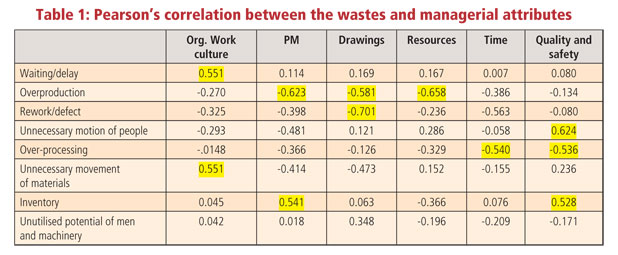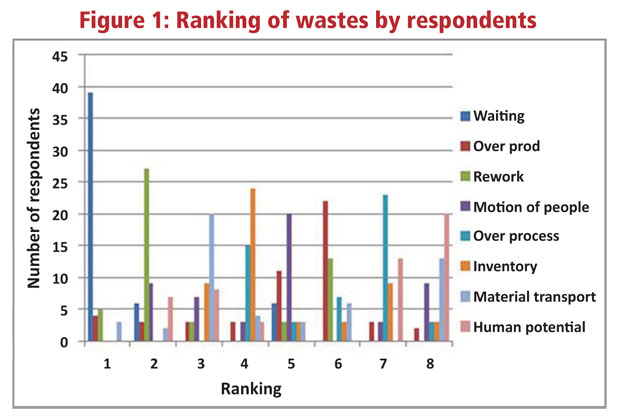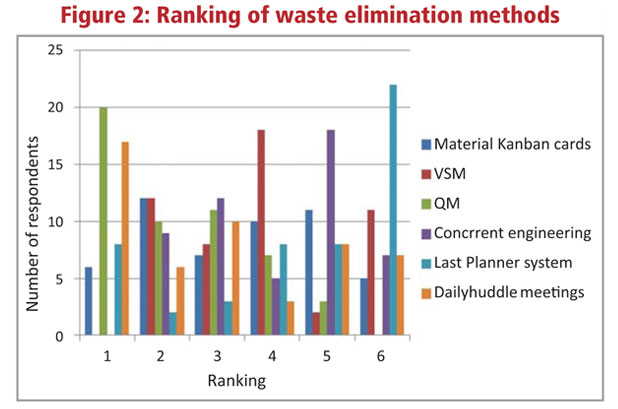- Home
- Technology
- Lean Construction Methods

Lean Construction Methods
Construction constitutes
40-50 per cent of India's capital expenditure on projects in various sectors such as highways, roads, railways, energy, airports and irrigation, and is the second largest industry in India after agriculture. It accounts for about 11 per cent of India's GDP and employs over 35 million people. The cost structure of the construction industry is dominated by the costs of raw material and subcontracting. Raw material û the major cost - accounts for 30-50 per cent of total cost and subcontracting accounts for about 20-40 per cent. The quantum of stalled projects continues to remain high during FY15 though the pace of new project stalling has come down and revival of stalled projects has increased. India is already on the verge of the development of smart cities across the country. As construction activity is labour-intensive, construction companies are now mainly focusing on mechanisation. Consequently, growth in quantum of labourers required has declined from 1.6 per cent to 0.9 per cent. Currently, projects in the construction industry are mostly working capital-intensive. The industry brings with it some seriously wasteful practices and struggles to satisfy the parties involved. Besides, it has the unfortunate reputation of delivering projects that are unpredictable in terms of delivery on time, within budget and to pre-specified quality, while concurrently attempting to ensure a zero accident rate. Those who strive for a better construction context thus set their eyes on the manufacturing industry. One revolutionary practice, rooted in the manufacturing industry, is lean production. Hence, the industry has forayed into lean philosophies for construction.
This philosophy is dedicated to eliminate both hidden and obvious waste. Lean thinking revels on the fundamental principles of value, value stream, flow, pull and perfection. Lean is focused more on value instead of cost, which it seeks through the removal of non-value adding activities while improving those that add value.
Lean digital construction
Lean construction has dramatically reduced jobsite accident rates, with rates being reduced by up to half the norm. Cost reduction can reach up to 25 per cent compared to the traditional project management approach. This has resulted in 30 per cent increase in productivity by matching labour with the workflow of backlog and shielding direct production from upstream variation and uncertainty.
The construction industry, now a rearing giant in this age of infrastructure, is beset with many challenges that include:
- High rate of snags and poor quality.
- Disorganised workplace.
- Higher effort on non value-adding activities.
- Poor communication and synergy among stakeholders.
- Always being busy with crisis management.
- Low labour productivity.
- Low output owing to frequent roadblocks and interruptions.
Lean digital is a new management philosophy that has interwoven the principles of lean construction with evolving technological advances. The technology strives to empower customers and enhance the performance of the business by leveraging real-time collaborative intelligence. The lean digital method of management creates new business opportunities and harvests business performance better, aligning with and responding to the needs of a hyper-connected world.

Managerial construction wastes
There are seven prerequisites to starting any activity in construction and falling short of any preconditions can generate waste. Lean construction is the continuous process of eliminating waste, focusing on the entire value stream and pursuing perfection in the execution of a constructed project. At the end of every project, at least 20 per cent of the purchased material will be unused; this material ends up as waste in most cases - and material accounts for over 50 per cent of project cost. It has been estimated that 33 per cent of on-site waste is owing to architects´ failure to implement waste reduction measures during the design stage. This, in addition to the complexity of construction projects, results in the design process overflow to the next stage, ie, construction, in the form of delays, deficient information and poorly constructible design solutions. The stages of construction in which the waste occurs: First, during the processes preceding construction operation; and second, during the operational construction stage. Wastes can also be classified into material waste and time waste; they have also been categorised into eight broad categories as per the lean philosophy.
Methodology
For this study, the construction industry comprising both the infrastructure and real-estate sectors has been considered. As lean concepts are still at a premature stage in the Indian construction industry, the population selected for study includes firms that have lean management methodology in place and those that don´t. With reference to the fact that most construction firms are unaccustomed to the lean concept by itself, the concept of lean digital is far from reality. Data was collected through a questionnaire survey with a sample size of 51.

Results
Based on the responses obtained, the wastes and their correlation with managerial attributes were studied. The inference from Pearson´s correlation is drawn based on the following ranges (Thomas J Archdeacon):
High: 0.5 to 1.0 or -0.5 to -1.0 9 (indicated in yellow in Table 1).
Medium: 0.3 to 0.5 or -0.3 to -0.5.
Low: 0.1 to 0.3 or -0.1 to -0.3.

Conclusion
With further analysis through Pearson´s correlation, the following inferences were made:
- Organisation work culture is the primary contributor to waste generation.
- The greater the management of drawings and resources, lesser the waste owing to overproduction.
- Rework is highly correlated to drawings.
- Quality and safety aspects are more related to wastes owing to unnecessary motion of people.
- Time and quality management have an impact on over-processing.
- Wastes owing to unnecessary movement of materials are attributed to a lack of reinforced organisation work culture.
- Improper project management results in wastes owing to excess inventory.
- Waste owing to unutilised human potential has been touched upon by all attributes.
- These managerial wastes take a heavy toll on the cost and time parameters of a project and, hence, ascertain the success or failure of a project.
Quality has always been the key to improved and better output. The results of the survey have demonstrated the pulse of the construction industry (as seen in Figure 2). The ranking of the elimination methods is only indicative of the preference of individual firms and not the efficiency of the methods. Thereby, it is essential to authenticate the fact that all elimination methods in collaboration would only result in an industry devoid of wastes.
Recommendations
The construction industry lacks a systematic construction process waste management system that can guide the implementation of lean construction. Systematic identification and quantification of waste is often one of the most challenging aspects for advocates of lean construction.
One major problem in construction involves the area of supply chain management and design information. These are bottlenecks that inhibit the flow in the construction process, causing roadblocks for further value generation. To view the entire value stream, the process must be observed from the onset to the end of the project. Various new tools and technologies have been emerging in the world of lean construction. Some of them are as follows:
- Device convergence: Phablets to replace tablets on-site.
- Augmented reality and wearables to make BIM and VDC more accessible.
- Near-field communications (NFC) to gain popularity onsite.
- Use of BIM technology.
- Virtual plan rooms.
- Drone technology.
- 4D modelling to demonstrate construction delays.
- Identification tags and part-oriented construction.
To achieve the consolidation period in construction automation, efforts need to be made on different fronts: Integration; prefabrication; robots and automated machines; and investment in R&D.
About the Authors:
Dr Yamini Varma is Associate Professor of NICMAR, Hyderabad; Dr Subhash Rastogi is Chairman of BT & BT Management Consultancy; and other contributors include PGPACM students of NICMAR, Hyderabad.
To share your views on this article, write in at feedback@constructionworld.in
DR YAMINI VARMA and DR SUBHASH RASTOGI write on the managerial perspective of lean waste assessment in the Indian construction scenario and share a blueprint for elimination of wastes through lean digital methods. Construction constitutes 40-50 per cent of India's capital expenditure on projects in various sectors such as highways, roads, railways, energy, airports and irrigation, and is the second largest industry in India after agriculture. It accounts for about 11 per cent of India's GDP and employs over 35 million people. The cost structure of the construction industry is dominated by the costs of raw material and subcontracting. Raw material û the major cost - accounts for 30-50 per cent of total cost and subcontracting accounts for about 20-40 per cent. The quantum of stalled projects continues to remain high during FY15 though the pace of new project stalling has come down and revival of stalled projects has increased. India is already on the verge of the development of smart cities across the country. As construction activity is labour-intensive, construction companies are now mainly focusing on mechanisation. Consequently, growth in quantum of labourers required has declined from 1.6 per cent to 0.9 per cent. Currently, projects in the construction industry are mostly working capital-intensive. The industry brings with it some seriously wasteful practices and struggles to satisfy the parties involved. Besides, it has the unfortunate reputation of delivering projects that are unpredictable in terms of delivery on time, within budget and to pre-specified quality, while concurrently attempting to ensure a zero accident rate. Those who strive for a better construction context thus set their eyes on the manufacturing industry. One revolutionary practice, rooted in the manufacturing industry, is lean production. Hence, the industry has forayed into lean philosophies for construction. This philosophy is dedicated to eliminate both hidden and obvious waste. Lean thinking revels on the fundamental principles of value, value stream, flow, pull and perfection. Lean is focused more on value instead of cost, which it seeks through the removal of non-value adding activities while improving those that add value. Lean digital construction Lean construction has dramatically reduced jobsite accident rates, with rates being reduced by up to half the norm. Cost reduction can reach up to 25 per cent compared to the traditional project management approach. This has resulted in 30 per cent increase in productivity by matching labour with the workflow of backlog and shielding direct production from upstream variation and uncertainty. The construction industry, now a rearing giant in this age of infrastructure, is beset with many challenges that include: High rate of snags and poor quality. Disorganised workplace. Higher effort on non value-adding activities. Poor communication and synergy among stakeholders. Always being busy with crisis management. Low labour productivity. Low output owing to frequent roadblocks and interruptions. Lean digital is a new management philosophy that has interwoven the principles of lean construction with evolving technological advances. The technology strives to empower customers and enhance the performance of the business by leveraging real-time collaborative intelligence. The lean digital method of management creates new business opportunities and harvests business performance better, aligning with and responding to the needs of a hyper-connected world. Managerial construction wastes There are seven prerequisites to starting any activity in construction and falling short of any preconditions can generate waste. Lean construction is the continuous process of eliminating waste, focusing on the entire value stream and pursuing perfection in the execution of a constructed project. At the end of every project, at least 20 per cent of the purchased material will be unused; this material ends up as waste in most cases - and material accounts for over 50 per cent of project cost. It has been estimated that 33 per cent of on-site waste is owing to architects´ failure to implement waste reduction measures during the design stage. This, in addition to the complexity of construction projects, results in the design process overflow to the next stage, ie, construction, in the form of delays, deficient information and poorly constructible design solutions. The stages of construction in which the waste occurs: First, during the processes preceding construction operation; and second, during the operational construction stage. Wastes can also be classified into material waste and time waste; they have also been categorised into eight broad categories as per the lean philosophy. Methodology For this study, the construction industry comprising both the infrastructure and real-estate sectors has been considered. As lean concepts are still at a premature stage in the Indian construction industry, the population selected for study includes firms that have lean management methodology in place and those that don´t. With reference to the fact that most construction firms are unaccustomed to the lean concept by itself, the concept of lean digital is far from reality. Data was collected through a questionnaire survey with a sample size of 51. Results Based on the responses obtained, the wastes and their correlation with managerial attributes were studied. The inference from Pearson´s correlation is drawn based on the following ranges (Thomas J Archdeacon): High: 0.5 to 1.0 or -0.5 to -1.0 9 (indicated in yellow in Table 1). Medium: 0.3 to 0.5 or -0.3 to -0.5. Low: 0.1 to 0.3 or -0.1 to -0.3. Conclusion With further analysis through Pearson´s correlation, the following inferences were made: Organisation work culture is the primary contributor to waste generation. The greater the management of drawings and resources, lesser the waste owing to overproduction. Rework is highly correlated to drawings. Quality and safety aspects are more related to wastes owing to unnecessary motion of people. Time and quality management have an impact on over-processing. Wastes owing to unnecessary movement of materials are attributed to a lack of reinforced organisation work culture. Improper project management results in wastes owing to excess inventory. Waste owing to unutilised human potential has been touched upon by all attributes. These managerial wastes take a heavy toll on the cost and time parameters of a project and, hence, ascertain the success or failure of a project. Quality has always been the key to improved and better output. The results of the survey have demonstrated the pulse of the construction industry (as seen in Figure 2). The ranking of the elimination methods is only indicative of the preference of individual firms and not the efficiency of the methods. Thereby, it is essential to authenticate the fact that all elimination methods in collaboration would only result in an industry devoid of wastes. Recommendations The construction industry lacks a systematic construction process waste management system that can guide the implementation of lean construction. Systematic identification and quantification of waste is often one of the most challenging aspects for advocates of lean construction. One major problem in construction involves the area of supply chain management and design information. These are bottlenecks that inhibit the flow in the construction process, causing roadblocks for further value generation. To view the entire value stream, the process must be observed from the onset to the end of the project. Various new tools and technologies have been emerging in the world of lean construction. Some of them are as follows: Device convergence: Phablets to replace tablets on-site. Augmented reality and wearables to make BIM and VDC more accessible. Near-field communications (NFC) to gain popularity onsite. Use of BIM technology. Virtual plan rooms. Drone technology. 4D modelling to demonstrate construction delays. Identification tags and part-oriented construction. To achieve the consolidation period in construction automation, efforts need to be made on different fronts: Integration; prefabrication; robots and automated machines; and investment in R&D. About the Authors: Dr Yamini Varma is Associate Professor of NICMAR, Hyderabad; Dr Subhash Rastogi is Chairman of BT & BT Management Consultancy; and other contributors include PGPACM students of NICMAR, Hyderabad. To share your views on this article, write in at feedback@constructionworld.in




















